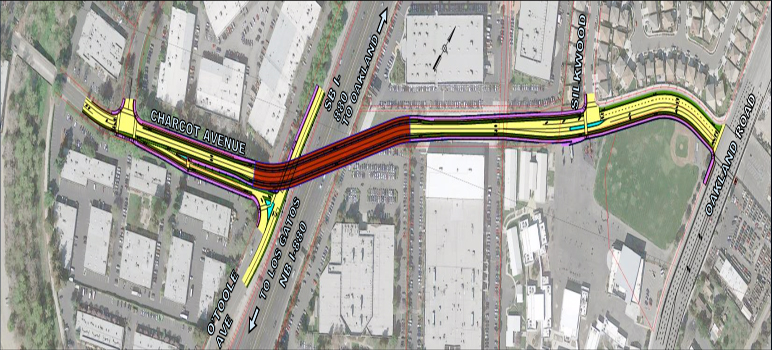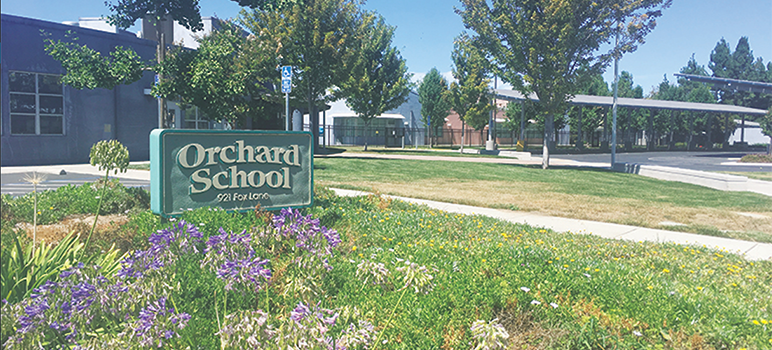Parents and teachers at Orchard Elementary School spent the past two years trying to prevent San Jose from building a highway overpass to Charcot Avenue, a project that tested the city’s so-called Vision Zero promise to eliminate traffic deaths.
That battle has now moved to court.
The parent-teacher group, called Protecting the Children of Orchard School, filed a lawsuit Tuesday against the city to prevent the overpass from becoming a reality.
Plaintiffs allege that San Jose’s final environmental impact review—a mandatory step in the planning process to weigh a project’s potential detriments—is “legally inadequate” under the standards set by the California Environmental Quality Act.
The project would extend Charcot Avenue from Paragon Drive to Oakland Road by way of an overpass that stretches across I-880.
But the crux of the issue for parents, teachers and neighbors supporting the lawsuit is that those plans were crafted back in 1994—long before the city signed onto Vision Zero, a commitment to reduce traffic deaths and injuries, in part, through safer infrastructure.

The Charcot Avenue Extension project has been part of San Jose's general plan since 1994. (Image via City of San Jose)
In the 26 years since the city adopted the general plan blueprints that called for the overpass, the industrial neighborhood has transformed, putting down more residential roots in addition to the elementary school campus on Fox Avenue.
Opponents of the project say the overpass would worsen pollution and induce more car traffic that would endanger children walking to school. San Jose would also need to invoke eminent domain to carve out a half-acre of the school’s playground.
City officials, however, say the project is foundational to North San Jose’s growth.
In June, the City Council practically cemented the fate of the proposed overpass when they voted 6-3 to send it to the final design phase. Council members Pam Foley, Magdalena Carrasco and Raul Peralez cast the dissenting votes. Their colleagues Maya Esparza and Sylvia Arenas were absent.
Seeing no other way around the council’s decision that night, parents and teachers who opposed the project decided to take legal action.
Robin Roemer, one of the parents leading the legal charge, said that despite two years of begging and arguing with city officials, their pleas fell on “deaf ears.”
“I don’t see any other way of trying to protect our children,” he said about the lawsuit. “It’s not something I think that any of us wants to do or was looking forward to, but we’re running out of options and it sometimes felt as if that was the city staff’s plan to try to ram this through with the thought of what is the community going to do?”
Oakland-based Aqua Terra Aeris Law Group, which specializes in environmental justice cases, prepared the 17-page civil complaint that details numerous examples in which the city allegedly “failed to evaluate” or “assess the full scope” of environmental impacts.
The impacts, according to the lawsuit, include increased traffic, pollution and noise.
Erin McCarthy, president of the Orchard Teachers’ Association, has worked as an instructor at the school since 1999. In her view, the city is prioritizing cars over children.
“It would impact our learning environment exponentially,” she said. “It’s taking a good portion of our campus away and we already don’t have a lot of space.”
McCarthy also expressed concerns about student safety since many children walk to campus or use the playground after hours and on weekends.
The city plans to install a high-visibility crosswalk at Fox Lane and Ridder Park Drive, but for many parents and teachers, that isn’t enough.
“There’s absolutely no way to make it zero danger,” McCarthy said. “But I don’t think it’s OK to make it more dangerous.”
To cover the group’s legal costs, Roemer set up a GoFundMe, which raised more than $2,000 in the first five days. He estimates they will need about $15,000 for the legal battle. Any leftover dollars will be redirected to the school’s PTA.
The city of San Jose, through Acting City Attorney Nora Frimann, declined to comment.


Why is this very expensive overpass needed, when cars can get past 880via Brokaw or Montague? Fix the potholes on city streets.
It will be interesting to see if the three Councilmembers who all voted against this extension all end up being candidates for mayor. It’s well rumored that Carrasco and Peralez are looking into it, and Foley might be the best business candidate SVO has, considering she’s a lifelong Democrat and a woman. (I’m genuinely sorry for commodifying her in those terms, but this is how strategists think based on voting behavior)
If this project, as it has been described, is necessary for the growth of housing in District 4 (which would likely lead to more congestion on Brokaw and Montague otherwise), then this is not far off from the Not In My Backyard-ism that has driven the housing crisis, in which politicians continually sell out future constituencies to win votes in the short-term.
I’m not dismissing the importance of trying to protect children, but we can’t plan a city if we start from the belief that anything that puts more traffic past a school is unacceptable. Everything is about weighing pros and cons, and bad policy gets made when policy makers hold sacred cows. To use NYC as an example, de Blasio rightfully recognized that schools were important institutions for the city’s vulnerable residents, but for the beginning of the city’s coronavirus pandemic he irrationally applied this concept, starting from the position that no matter what the schools had to stay open. Similarly, we can rightfully recognize that safety is a paramount concern, but it’s not an all-consuming concern, otherwise we wouldn’t leave our homes. When I weigh the cost of not allowing San Jose to grow vs the minor potential danger of this extension, I see a lopsided scale. We need to end this housing crisis that’s been created by, among more pernicious motivations, an over-exaggeration of the costs of traffic.
Hi “Maybe A Little Too Cyncial”,
I wanted to address a few of the points that you raise and to maybe provide some clarification or context as I appreciate your thoughtful comments.
You are right, building more housing is absolutely necessary and in fact I can think of a few parcels close to the school (on Oakland Road for example) that I would love to see get more developed and I think most in the community would support that. Many of our families are struggling financially and the housing crisis is very real to us.
Weighing growth against local impacts is a tough choice and compromises need to be made – therefore our proposal of a bike-ped bridge. We are not against growth. We are against mindlessly following a 25-year plan and we challenge the City to prove that this project is as essential as they claim and to explain why a bike-ped connection would be worse for economic growth or would limit housing in any way.
It might be important to highlight:
1. No developer, realtor, housing advocate or business group (or any other organized interest) has come out in favor of this project.
2. City staff has concluded: “The proposed extension will provide little to no measurable travel time savings when considering the size of the proposed Charcot extension in relation to the overall roadway system in the project area and the projected development growth.”
3. The road is – according to the EIR – NOT built so that MORE people can drive into NSJ. It’s just to re-distribute trips that are made regardless of if the project gets built or not. The EIR also explicitly states that the project would not noticeably impact congestion on Brokaw or Montague. If you think this is hard to believe, I know a lawsuit you can join :)
To quickly contrast this with the impacts of the proposed Charcot Extension:
I think I know what you are referring to when you speak of “an over-exaggeration of the costs of traffic”. If this road were for a few hundred cars a day, that would be one thing. The EIR itself speaks of 13,000 cars per day, a prior official study, that the City tried to keep outside of the public eye, came to the conclusion that the overpass would add about 20,000 cars per day to the school zone. I haven’t seen many development projects that would have a similar impact – especially not in areas with a different demographic than our public school. I wouldn’t wish this upon any school. To us it’s NI-any-BY.
MTC (not the most NIMBY of organizations out there) has concluded that there is no safe level of exposure to fine particular matter PM2.5 (coming from e.g. exhaust, tires, road dust) and that we need to do more reduce exposure. Numerous studies have shown that the impact of PM2.5 is particular damaging to children. The air pollution impacts from 20.000 additional cars are not trivial. The Air District (BAAQMD) – also hard to characterize as a NIMBY organization, has also opposed this project for exactly these reasons.
In this particular case it seems that the benefits seem to be mostly theoretically or based on a certain “belief-system” (“more space for cars = more economic development” – an equation that doesn’t have a particularly good track record). The EIR did not analyze what the impact on housing development would be if the City builds the bike-ped connection instead of a road. I’m also not aware of any other City document that would provide data on this. Admittedly, a difficult thing to show, but as the City is proposing to put our children at risk (and use our taxpayer money for it) we are asking for a little bit more than “just trust us blindly that this is necessary”.
You are right that we can’t have growth without building out infrastructure, but that doesn’t mean all proposals for new infrastructure automatically make sense or are a wise investment.
Almost every project sees local protests nowadays, so it’s easy to look at protest and say “they are NIMBY”, but sometimes local communities have indeed legitimate concerns – and I think letters of support from citywide and regional groups show that in this case.
What makes this case so this case so difficult and one of the reason we are challenging the EIR is that half of the time the EIR says this would be a major roadway improvement necessary for major housing and commercial development in North San Jose, but then at the same time it also argues this will be a small, local street with minimal impacts. Which one do you think is right?
Happy to chat more if you are interested.